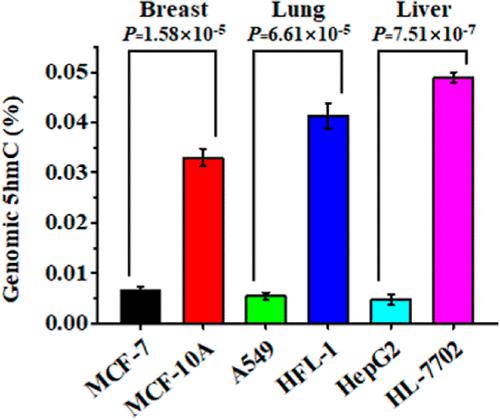当前位置:
X-MOL 学术
›
Anal. Chem.
›
论文详情
Our official English website, www.x-mol.net, welcomes your
feedback! (Note: you will need to create a separate account there.)
Hydroxymethylation-Specific Ligation-Mediated Single Quantum Dot-Based Nanosensors for Sensitive Detection of 5-Hydroxymethylcytosine in Cancer Cells
Analytical Chemistry ( IF 6.7 ) Pub Date : 2022-06-24 , DOI: 10.1021/acs.analchem.2c01495 Zi-Yue Wang 1 , Huimin Yuan 2 , Dong-Ling Li 1 , Juan Hu 2 , Jian-Ge Qiu 3 , Chun-Yang Zhang 1
Analytical Chemistry ( IF 6.7 ) Pub Date : 2022-06-24 , DOI: 10.1021/acs.analchem.2c01495 Zi-Yue Wang 1 , Huimin Yuan 2 , Dong-Ling Li 1 , Juan Hu 2 , Jian-Ge Qiu 3 , Chun-Yang Zhang 1
Affiliation

|
5-Hydroxymethylcytosine (5hmC) modification is a key epigenetic regulator of cellular processes in mammalian cells, and its misregulation may lead to various diseases. Herein, we develop a hydroxymethylation-specific ligation-mediated single quantum dot (QD)-based fluorescence resonance energy transfer (FRET) nanosensor for sensitive quantification of 5hmC modification in cancer cells. We design a Cy5-modified signal probe and a biotinylated capture probe for the recognition of specific 5hmC-containing genes. 5hmC in target DNA can be selectively converted by T4 β-glucosyltransferase to produce a glycosyl-modified 5hmC, which cannot be cleaved by methylation-insensitive restriction enzyme MspI. The glycosylated 5hmC DNA may act as a template to ligate a signal probe and a capture probe, initiating hydroxymethylation-specific ligation to generate large amounts of biotin-/Cy5-modified single-stranded DNAs (ssDNAs). The assembly of biotin-/Cy5-modified ssDNAs onto a single QD through streptavidin–biotin interaction results in FRET and consequently the generation of a Cy5 signal. The nanosensor is very simple without the need for bisulfite treatment, radioactive reagents, and 5hmC-specific antibodies. Owing to excellent specificity and high amplification efficiency of hydroxymethylation-specific ligation and near-zero background of a single QD-based FRET, this nanosensor can quantify 5hmC DNA with a limit of detection of 33.61 aM and a wider linear range of 7 orders of magnitude, and it may discriminate the single-nucleotide difference among 5hmC, 5-methylcytosine, and unmodified cytosine. Moreover, this nanosensor can distinguish as low as a 0.001% 5hmC DNA in complex mixtures, and it can monitor the cellular 5hmC level and discriminate cancer cells from normal cells, holding great potential in biomedical research and clinical diagnostics.
中文翻译:

羟甲基化特异性连接介导的单量子点纳米传感器灵敏检测癌细胞中的 5-羟甲基胞嘧啶
5-羟甲基胞嘧啶(5hmC)修饰是哺乳动物细胞中细胞过程的关键表观遗传调节因子,其错误调节可能导致各种疾病。在此,我们开发了一种基于羟甲基化特异性连接介导的单量子点 (QD) 的荧光共振能量转移 (FRET) 纳米传感器,用于对癌细胞中的 5hmC 修饰进行灵敏量化。我们设计了一个 Cy5 修饰的信号探针和一个生物素化的捕获探针,用于识别特定的含有 5hmC 的基因。靶 DNA 中的 5hmC 可被 T4 β-葡糖基转移酶选择性转化,产生糖基修饰的 5hmC,该 5hmC 不能被甲基化不敏感的限制性内切酶 MspI 切割。糖基化的 5hmC DNA 可以作为模板连接信号探针和捕获探针,启动羟甲基化特异性连接以产生大量生物素/Cy5 修饰的单链 DNA (ssDNA)。通过链霉亲和素-生物素相互作用将生物素/Cy5 修饰的 ssDNA 组装到单个 QD 上会导致 FRET 并因此产生 Cy5 信号。纳米传感器非常简单,无需亚硫酸氢盐处理、放射性试剂和 5hmC 特异性抗体。由于羟甲基化特异性连接的优异特异性和高扩增效率以及单个基于 QD 的 FRET 的近零背景,该纳米传感器可以以 33.61 aM 的检测限和 7 个数量级的更宽线性范围量化 5hmC DNA , 它可以区分 5hmC、5-甲基胞嘧啶和未修饰胞嘧啶之间的单核苷酸差异。而且,
更新日期:2022-06-24
中文翻译:

羟甲基化特异性连接介导的单量子点纳米传感器灵敏检测癌细胞中的 5-羟甲基胞嘧啶
5-羟甲基胞嘧啶(5hmC)修饰是哺乳动物细胞中细胞过程的关键表观遗传调节因子,其错误调节可能导致各种疾病。在此,我们开发了一种基于羟甲基化特异性连接介导的单量子点 (QD) 的荧光共振能量转移 (FRET) 纳米传感器,用于对癌细胞中的 5hmC 修饰进行灵敏量化。我们设计了一个 Cy5 修饰的信号探针和一个生物素化的捕获探针,用于识别特定的含有 5hmC 的基因。靶 DNA 中的 5hmC 可被 T4 β-葡糖基转移酶选择性转化,产生糖基修饰的 5hmC,该 5hmC 不能被甲基化不敏感的限制性内切酶 MspI 切割。糖基化的 5hmC DNA 可以作为模板连接信号探针和捕获探针,启动羟甲基化特异性连接以产生大量生物素/Cy5 修饰的单链 DNA (ssDNA)。通过链霉亲和素-生物素相互作用将生物素/Cy5 修饰的 ssDNA 组装到单个 QD 上会导致 FRET 并因此产生 Cy5 信号。纳米传感器非常简单,无需亚硫酸氢盐处理、放射性试剂和 5hmC 特异性抗体。由于羟甲基化特异性连接的优异特异性和高扩增效率以及单个基于 QD 的 FRET 的近零背景,该纳米传感器可以以 33.61 aM 的检测限和 7 个数量级的更宽线性范围量化 5hmC DNA , 它可以区分 5hmC、5-甲基胞嘧啶和未修饰胞嘧啶之间的单核苷酸差异。而且,











































 京公网安备 11010802027423号
京公网安备 11010802027423号